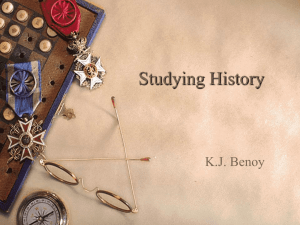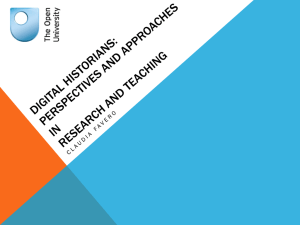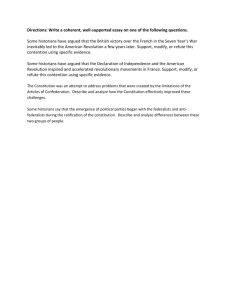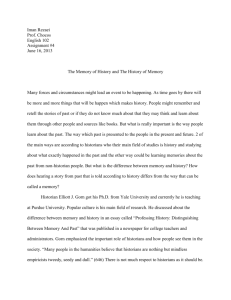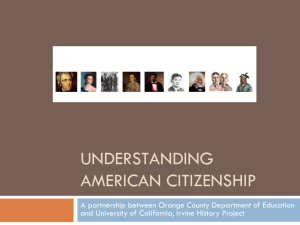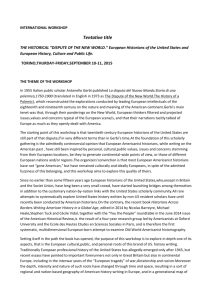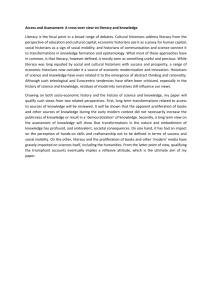Why Study History and Who Are These Historians
advertisement
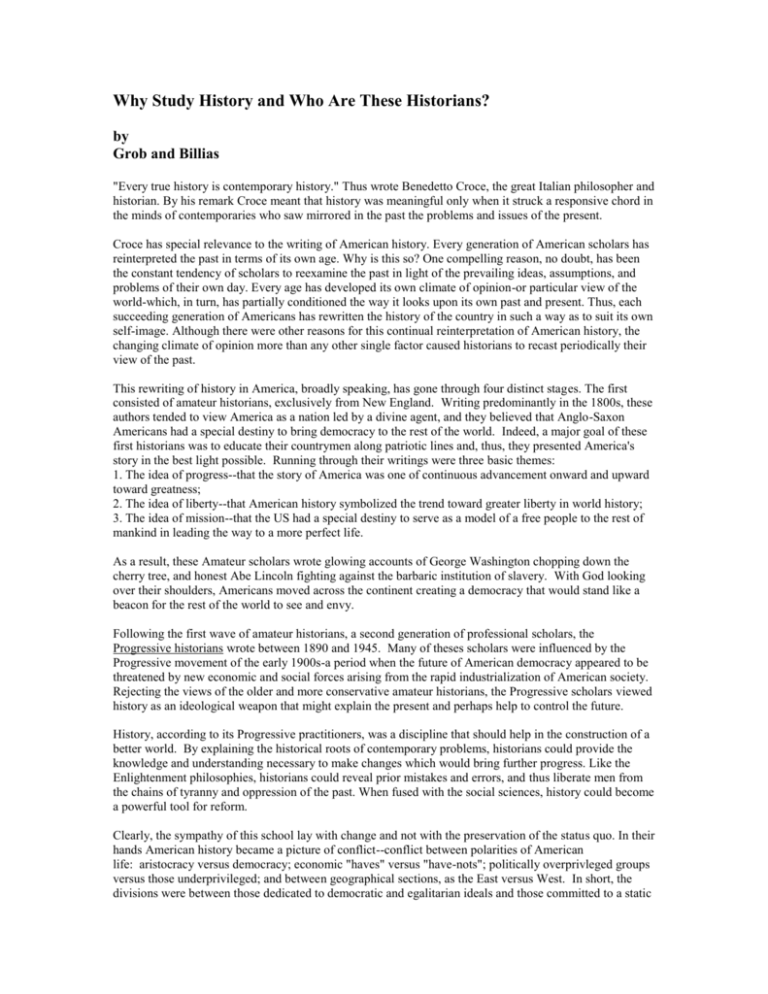
Why Study History and Who Are These Historians? by Grob and Billias "Every true history is contemporary history." Thus wrote Benedetto Croce, the great Italian philosopher and historian. By his remark Croce meant that history was meaningful only when it struck a responsive chord in the minds of contemporaries who saw mirrored in the past the problems and issues of the present. Croce has special relevance to the writing of American history. Every generation of American scholars has reinterpreted the past in terms of its own age. Why is this so? One compelling reason, no doubt, has been the constant tendency of scholars to reexamine the past in light of the prevailing ideas, assumptions, and problems of their own day. Every age has developed its own climate of opinion-or particular view of the world-which, in turn, has partially conditioned the way it looks upon its own past and present. Thus, each succeeding generation of Americans has rewritten the history of the country in such a way as to suit its own self-image. Although there were other reasons for this continual reinterpretation of American history, the changing climate of opinion more than any other single factor caused historians to recast periodically their view of the past. This rewriting of history in America, broadly speaking, has gone through four distinct stages. The first consisted of amateur historians, exclusively from New England. Writing predominantly in the 1800s, these authors tended to view America as a nation led by a divine agent, and they believed that Anglo-Saxon Americans had a special destiny to bring democracy to the rest of the world. Indeed, a major goal of these first historians was to educate their countrymen along patriotic lines and, thus, they presented America's story in the best light possible. Running through their writings were three basic themes: 1. The idea of progress--that the story of America was one of continuous advancement onward and upward toward greatness; 2. The idea of liberty--that American history symbolized the trend toward greater liberty in world history; 3. The idea of mission--that the US had a special destiny to serve as a model of a free people to the rest of mankind in leading the way to a more perfect life. As a result, these Amateur scholars wrote glowing accounts of George Washington chopping down the cherry tree, and honest Abe Lincoln fighting against the barbaric institution of slavery. With God looking over their shoulders, Americans moved across the continent creating a democracy that would stand like a beacon for the rest of the world to see and envy. Following the first wave of amateur historians, a second generation of professional scholars, the Progressive historians wrote between 1890 and 1945. Many of theses scholars were influenced by the Progressive movement of the early 1900s-a period when the future of American democracy appeared to be threatened by new economic and social forces arising from the rapid industrialization of American society. Rejecting the views of the older and more conservative amateur historians, the Progressive scholars viewed history as an ideological weapon that might explain the present and perhaps help to control the future. History, according to its Progressive practitioners, was a discipline that should help in the construction of a better world. By explaining the historical roots of contemporary problems, historians could provide the knowledge and understanding necessary to make changes which would bring further progress. Like the Enlightenment philosophies, historians could reveal prior mistakes and errors, and thus liberate men from the chains of tyranny and oppression of the past. When fused with the social sciences, history could become a powerful tool for reform. Clearly, the sympathy of this school lay with change and not with the preservation of the status quo. In their hands American history became a picture of conflict--conflict between polarities of American life: aristocracy versus democracy; economic "haves" versus "have-nots"; politically overprivleged groups versus those underprivileged; and between geographical sections, as the East versus West. In short, the divisions were between those dedicated to democratic and egalitarian ideals and those committed to a static conservatism. Believers in inevitable progress, the Progressive historians assumed that America was continually moving on an upward path toward an ideal social order. Not only was American society growing in affluence, but in freedom, opportunity, and happiness as well. The primary determinant of progress was the unending conflict between the forces of liberalism and those of conservatism. Thus all periods in American history could be divided into two clear and distinct phases: periods of active reform and periods of conservative reaction. As Arthur M. Schlesinger, Sr., wrote in 1939: "A period of concern for the rights of the few has been followed by one of concern for the wrongs of the many." Frederick Jackson Turner, Charles A. Beard, and Vernon Parrington were the three greatest Progressive historians. Turner saw American as involved in a continuous sectional conflict--North vs South and East vs West. At the same time, Beard demonstrated that the Constitution, far from representing a judicious combination of wisdom and idealism, was actually the product of a small group of propertied individuals who were intent upon establishing a strong central government capable of protecting their interests against the encroachments of the American masses. The Progressive point of view generally dominated the field of American historical scholarship down to the end of World War II. Class and sectional conflict, Progressive historians implied, was a guarantor of progress. Even during those eras in American history when the forces of reaction triumphed-as in the postCivil War period-their victory was only temporary; ultimately the forces of progress and good regrouped and thereby gained the initiative once again. Such an approach, of course, led to broad and sweeping interpretive syntheses of American history, and the faith of historians in the ultimate triumph of good over evil remained unquestioned. In the 1930s, however, some American scholars began to question the idea of progress that was implicit in this Progressive view. The rise of Nazism in the 1930s and 1940s, and the menace of communism in the 1950s and 1960s, led to a questioning of older assumptions and generalities. How, some asked, could one subscribe to the optimistic tenets of liberalism after the horrors of Auschwitz, Buchenwald, Hiroshima, Nagasaki, and the threat of modern totalitarianism? Indeed, had not American historians, through their own optimistic view of history and their faith in progress, failed to prepare the American people for the challenges and trials that they would face during the middle of the twentieth century? By the end of World War II, therefore, a third group of historians appeared on the scene to challenge the Progressive point of view. They were sometimes called Neoconservatives because they harked back to the conservative historical position that had prevailed prior to Turner and Beard. These younger historians reflected an outlook that prevailed in the United States as the nation assumed the sober responsibility of defending the world against the threat of communism. During the Cold War era, when the country felt its security endangered from abroad, these scholars wanted to present an image to the rest of the world of an America that had been strong and united throughout most of its history. Hence, the neoconservative scholars pictured American history in terms of consensus rather than conflict. One way this new group of scholars differed from the Progressives was in their inherent conservatism. Progressive historians had had a deep belief in the idea of progress. Neoconservative historians, on the other hand, often rejected progress as an article of faith. Skeptical of the alleged beneficial results of rapid social change, they stressed instead the thesis of historical continuity. Given their emphasis on continuity, the neoconservatives were less prone to a periodized view of American history. Progressive scholars had seen American history in terms of class or sectional conflicts mark by clearly defined turning points-the Revolution, the Constitution, the Jeffersonian era, the Jacksonian period, the Civil War, and so forth. These periods represented breaks, or discontinuities, from what had gone on before. For the Progressives, American history was divided into two distinct phases that followed one another in a cyclical pattern: periods of reform or revolution when the popular and democratic forces in society gained the upper hand and forced social changes, and periods of reaction and counterrevolution, when vested interests resisted such changes. For the neoconservative scholars, however, the enduring and unifying themes in history were much more significant. To them the continuity of common principles in American culture, the stability and longevity of institutions, and the persistence of certain traits and traditions in the American national character represented the most powerful forces in history. Thus, consensus, as well as continuity, was a characteristic theme of the neoconservative historians. Moreover, the neoconservatives abandoned the conflict interpretation of history and favored instead one that viewed American society as stable and homogeneous. The cement that bound American society together throughout most of its history was a widespread acceptance of certain principles and beliefs. Americans, despite their differences, had always agreed on the following propositions: the right of all persons in society to own private property; the theory that the power of government should always be limited; the concept that men possessed certain natural rights that could not be taken from them by government; and the idea of some form of natural law. Neoconservative scholars published specialized studies which revised the Progressive point of view in virtually every period of American history. The neoconservative trend, marked by a new respect for tradition and a de-emphasis on class conflict, brought many changes in American historiography: the revival of a sympathetic approach to the Puritans; the treatment of the American Revolution as a conservative movement of less significance, and the conclusion that the Constitution was a document faithfully reflecting a middle-class consensus. Implicit in the neoconservative approach was a fear of extremism, a yearning to prove that national unity had almost always existed, and a longing for the security and way of life America presumably had enjoyed before becoming a superpower and leader of the free world. The Fourth stage of historical writing began in the 1950s, but it only became dominant after the War in Vietnam. During the decades of the 1960s and 1970s, the assumptions and conclusions of the neoconservative historians were rudely overturned when the mood of the American people shifted markedly as the seemingly placid decade of the 1950s was succeeded by tumultuous events in America's foreign and domestic affairs. The prevailing mood among the American people shifted dramatically in the 1960s and 1970s because of a series of shattering events on the domestic scene. Gone were the complacency, national self confidence, optimism, and moral composure that seemed to have characterized the 1950s. Many historians were stirred by the great social upheavals that undermined previously held assumptions. A marked trend toward racial divisions within American society appeared with the newfound militancy among blacks during the civil rights movement. The resulting hostility to integration among many whites showed that American society was hardly as homogeneous as had been previously believed. At the same time, an increased tendency toward violence during the urban riots in the 1960s indicated that Americans were not always committed to the idea of peaceful compromise. President Kennedy's assassination in 1963 followed by that of Martin Luther King and, Robert Kennedy revealed that the United States was as vulnerable to political terrorism as other societies. There was also a renewed awareness of poverty with the economic downturn in the 1970s, and some scholars began voicing doubts about the supposed social mobility within American society, the virtues of technological change, and the benefits of economic growth. The appearance of numerous social-protest movements during those two decades also made many American historians more conscious of the importance of minority groups in the nation's past. Having witnessed protest movements by the blacks, the poor, and the women's liberation movement, some scholars took a greater interest in black history, women's history, and to protest groups like the Populists and IWW. Generally speaking, historians became more sympathetic to the role of the underdog in American history. Changes in America's foreign affairs during these decades similarly had a profound effect on the writing of history. The Vietnam War, above all, divided the American people. Students participated in large-scale antiwar demonstrations, and college campuses were transformed into centers of political protest and activism. Many intellectuals grew disenchanted with the government's military policy and became increasingly suspicious of the political establishment in general. The Vietnam War also exposed the dangers of what one historian termed the imperial presidency. President Nixon and the Watergate scandal revealed further the threat posed to constitutional government by this concept of the presidency. As some historians grew more critical of America's foreign policy, they began to question the credibility of the government both in the present and past. It was within this general context that there arose a significant challenge to the neoconservative historians in the 1960s from a group of younger radical scholars known as the New Left. Like the older Progressives, these historians sought to fuse historical scholarship with political activism, and might be called "neoProgressives." Unlike the neoconservatives who emphasized consensus, continuity, and stability, the New Left saw social and economic conflict as the major theme in American history. Of all historians, the individuals identified with the New Left were the most disenchanted with the course of events in recent American history. As a result they presented a radical critique of American society and took a more jaundiced view of the American past. These scholars reinterpreted American history along more radical lines and insisted that their colleagues pay far greater attention to the lower classes and minority groups of all kinds. Members of the New Left were exceedingly critical in particular, of those neoconservative scholars who tended to celebrate the virtues and achievements of the American people. Because the neoconservatives had excluded conflict in their interpretation, the New Left argued, the American people were unprepared to cope with the social upheavals that occurred in the 1960s. These younger historians declared that the resort to violence by social groups to achieve their goals was a theme that had deep roots in the American past. The New Left historians sought to create a "usable past"-a history that would account for the country's social problems such as racism, militarism, economic exploitation, and imperialism, and would serve as the basis for reforming American society. American history had too often been written from "the top down"-that is, from the point of view of elites and the articulate like Washington, Lincoln, and Franklin D. Roosevelt. History, they argued, should be written "from the bottom up," a perspective which would reflect the concerns of the common people, the inarticulate masses, and nonelites. Viewing history in this way, scholars would discover the radicalism inherent in the American past. In their treatment of America's foreign policy, for example, the New Left developed a much more critical interpretation than previous historians. America from its beginnings, they argued, had been an aggressive, expansionist, and imperialist nation. It expanded first at the expense of the Indians, and then later at the expense of its weaker neighbors like Mexico. The United States turned subsequently to an overseas imperialist foreign policy based on its need for foreign markets, raw materials, and investment opportunities. This expansionist foreign policy had global ramifications, the New Left claimed. America had played a major role in precipitating two world wars and was primarily responsible for bringing about the Cold War. The Vietnam War, according to the New Left, was simply a logical extension of America's aggressive and expansionist foreign policy.

